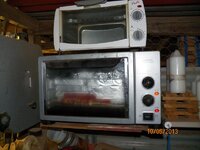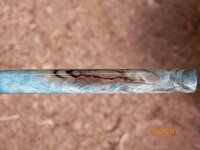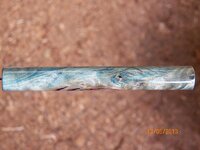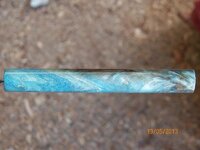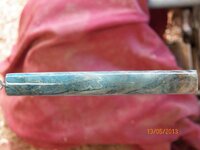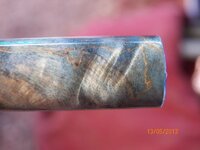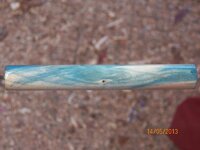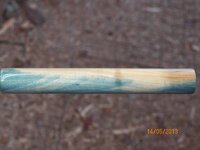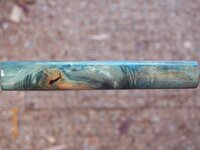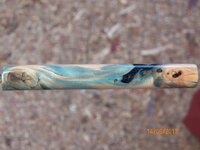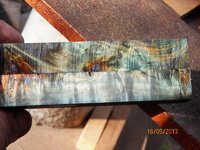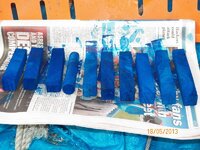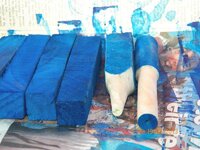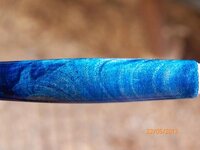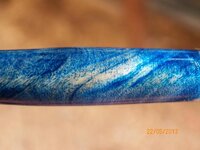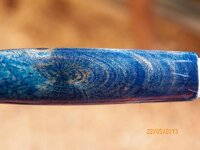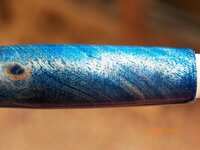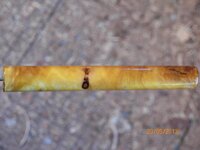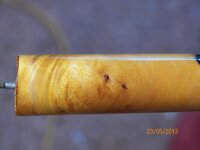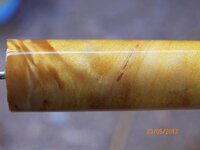robutacion
Member
Hi peoples,
Before we go any further, some people will be asking, what in heck is chatoyance...??? there many explanations but, the one I like the most is this "Chatoyance is the property of some materials to exhibit a wavy, luminous band with a silky lustre, reminiscent of the eye of a cat". A good example of this in wood is shown here,Woodworking - Creating chatoyance, vibrancy, 'popping the grain' - YouTube
There are plenty of wood types that have this natural ability and I have plenty of them but, some woods only show its chatoyance when enhanced with a darker colouration and a very shiny finish, this is what I found out of my Tortuosa Willow tree wood that produces a bark burl that most people love but also a great deal of chatoyance that is not visible in its light colour and natural raw stage.
Apart from the burl wood, the inner part of the tree wood is pretty average, light in colour, light in weight and little visible grain however, certain parts of the tree produces wood that is extremely dense, impermeable but still light in weight.
I've noticed that, not every blanks stains/stabilises well, even in the burl category but, the softest the wood the better it receives any foreign liquids. I have been doing some work/testing on different pieces of wood from different parts of the tree and I realise that, they all behave differently, as if they weren't part of the same tree species, much less part of the same tree, sometimes the same log.
I was able to recognise the parts of the wood that accepts dying/stabilising however the failure rate is still about 20%, as I just confirmed with my last dying/stabilisation batch, some simply don't soak and float like cork.
I'm using the Alumilite dyes supplied by Curtis, together with his Cactus Juice and while very concentrated stuff, I find that colours like the blue don't come up as blue as I would like, more like a green(ish) even tough I use 55 drops per litre of Juice.
This was the case with the batch I'm working on, they were under vacuum for 6 hours and then soaking all night, the next day I drain, wrapped them in foil (3 in each piece of foil) and cooked them for the 90 minutes at 90° Celsius.
I could see the ones that didn't soak (not much blue) and even if I had my eyes closed, I would be able to tell as the soaked ones were very heavy while the others were very light. I got them all out of the foil and proceed to turn one into a normal sample, as I do with any other blanks, what I noticed was that, while the blanks after unwrapped from the foil looked quite dark blue, as soon as I turn that surface away, the light blueish/greenish colour appears, and seems to be like that all though the wood.
It may not be as dark blue as I wanted but, the chatoyance is just amazing, I know that the blank I selected to turn isn't a third as pretty as many others (grain wise), I couldn't tell them apart with that dark blue skin of dry blue Juice covering the wood however, I think the blank looks pretty good...!
In an attempt to darken the blanks done, I decided to use all the blue dye I had (about 3/5 of the bottle capacity) into a 1 x gallon (3,7 lt) of juice, stir the heck out of it, put all be blanks back in the stabilisation chamber and pour the whole think on, it just covered the blanks, about 3/4" over, put the lid and fire the pump.
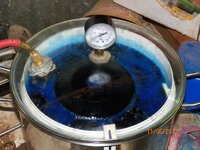
It started at 2:00pm afternoon and I turn the pump off at 9:00pm evening, they will be soaking again overnight so in the morning I will drain and cook then again. I could have done a double colour dye but I want a darker blue so, will see how they come up, sometime tomorrow.
I have my doubts that they will show much darker, the reason being is that, the first time around, the blanks soaked about 2.5lt of juice, this time, and looking at the amount of juice over the blanks when I turned the pump off, it didn't seem to have soaked anything at all so, will see if the overnight soaking alone will allow the wood to soak some more juice...!
For now, I can show you how the first sample come out from the first run, is this is it;
PS: I have tried to capture the chatoyance in the pics but, is almost an impossible task, I may have to put it inside the microwave, and see if I can get the table to turn without the heat and then use the video camera to record a couple of rotations, that should work, all the background is white so, I should have plenty of light for it. Hummm...! maybe the table will turn too fast...!
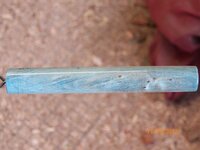
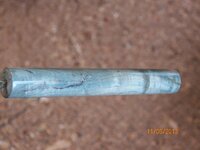
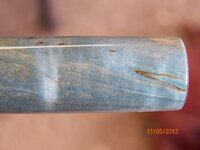
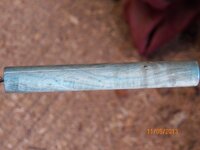
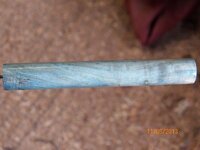
To be continued...
Cheers
George
Before we go any further, some people will be asking, what in heck is chatoyance...??? there many explanations but, the one I like the most is this "Chatoyance is the property of some materials to exhibit a wavy, luminous band with a silky lustre, reminiscent of the eye of a cat". A good example of this in wood is shown here,Woodworking - Creating chatoyance, vibrancy, 'popping the grain' - YouTube
There are plenty of wood types that have this natural ability and I have plenty of them but, some woods only show its chatoyance when enhanced with a darker colouration and a very shiny finish, this is what I found out of my Tortuosa Willow tree wood that produces a bark burl that most people love but also a great deal of chatoyance that is not visible in its light colour and natural raw stage.
Apart from the burl wood, the inner part of the tree wood is pretty average, light in colour, light in weight and little visible grain however, certain parts of the tree produces wood that is extremely dense, impermeable but still light in weight.
I've noticed that, not every blanks stains/stabilises well, even in the burl category but, the softest the wood the better it receives any foreign liquids. I have been doing some work/testing on different pieces of wood from different parts of the tree and I realise that, they all behave differently, as if they weren't part of the same tree species, much less part of the same tree, sometimes the same log.
I was able to recognise the parts of the wood that accepts dying/stabilising however the failure rate is still about 20%, as I just confirmed with my last dying/stabilisation batch, some simply don't soak and float like cork.
I'm using the Alumilite dyes supplied by Curtis, together with his Cactus Juice and while very concentrated stuff, I find that colours like the blue don't come up as blue as I would like, more like a green(ish) even tough I use 55 drops per litre of Juice.
This was the case with the batch I'm working on, they were under vacuum for 6 hours and then soaking all night, the next day I drain, wrapped them in foil (3 in each piece of foil) and cooked them for the 90 minutes at 90° Celsius.
I could see the ones that didn't soak (not much blue) and even if I had my eyes closed, I would be able to tell as the soaked ones were very heavy while the others were very light. I got them all out of the foil and proceed to turn one into a normal sample, as I do with any other blanks, what I noticed was that, while the blanks after unwrapped from the foil looked quite dark blue, as soon as I turn that surface away, the light blueish/greenish colour appears, and seems to be like that all though the wood.
It may not be as dark blue as I wanted but, the chatoyance is just amazing, I know that the blank I selected to turn isn't a third as pretty as many others (grain wise), I couldn't tell them apart with that dark blue skin of dry blue Juice covering the wood however, I think the blank looks pretty good...!
In an attempt to darken the blanks done, I decided to use all the blue dye I had (about 3/5 of the bottle capacity) into a 1 x gallon (3,7 lt) of juice, stir the heck out of it, put all be blanks back in the stabilisation chamber and pour the whole think on, it just covered the blanks, about 3/4" over, put the lid and fire the pump.

It started at 2:00pm afternoon and I turn the pump off at 9:00pm evening, they will be soaking again overnight so in the morning I will drain and cook then again. I could have done a double colour dye but I want a darker blue so, will see how they come up, sometime tomorrow.
I have my doubts that they will show much darker, the reason being is that, the first time around, the blanks soaked about 2.5lt of juice, this time, and looking at the amount of juice over the blanks when I turned the pump off, it didn't seem to have soaked anything at all so, will see if the overnight soaking alone will allow the wood to soak some more juice...!
For now, I can show you how the first sample come out from the first run, is this is it;
PS: I have tried to capture the chatoyance in the pics but, is almost an impossible task, I may have to put it inside the microwave, and see if I can get the table to turn without the heat and then use the video camera to record a couple of rotations, that should work, all the background is white so, I should have plenty of light for it. Hummm...! maybe the table will turn too fast...!





To be continued...
Cheers
George
Last edited:

